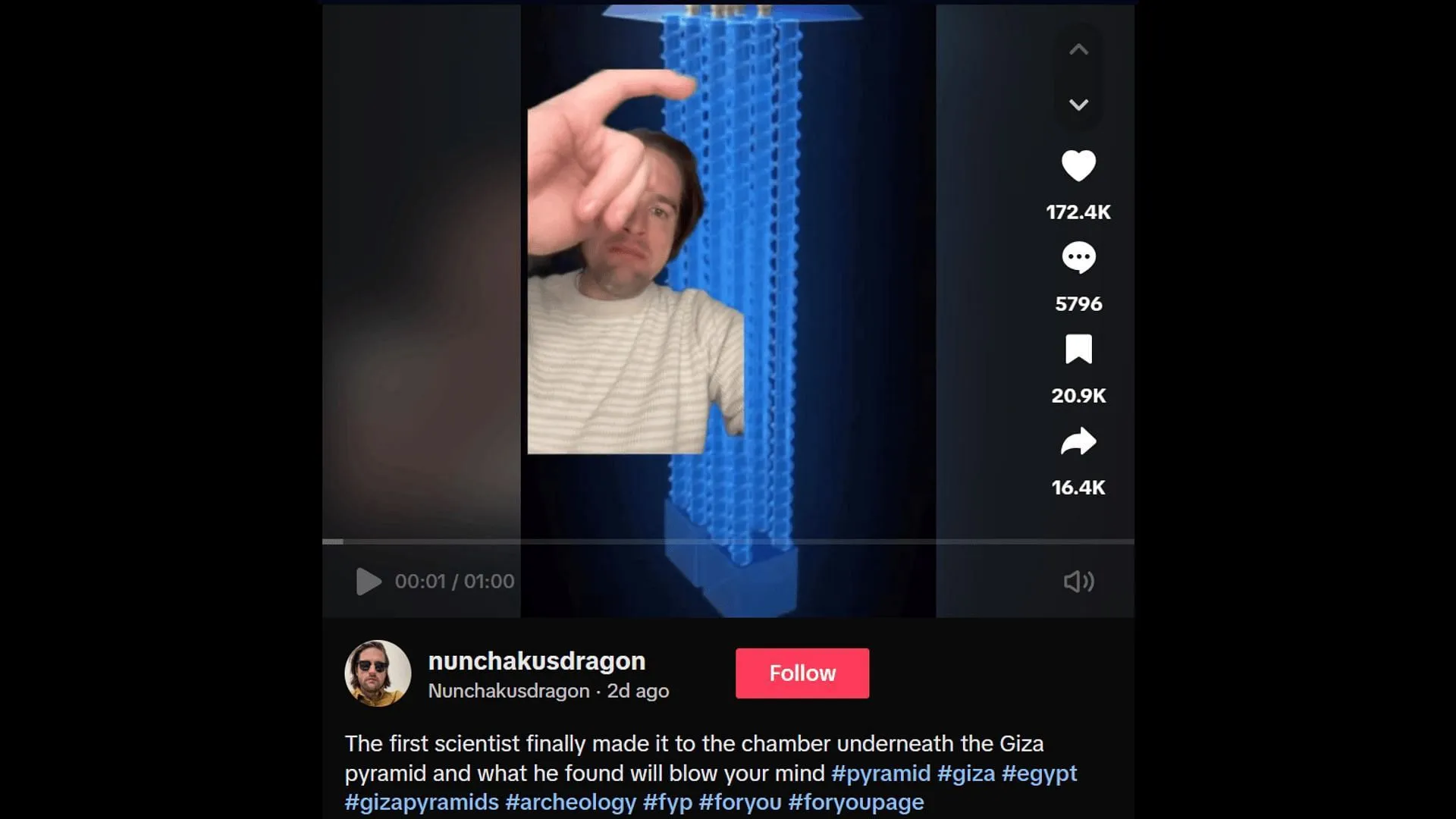Recently, a TikTok video gained significant attention, alleging that a scientist descended into the Khafre Pyramids at Giza to investigate a submerged labyrinth unearthed during 2022. The user, @nunchakusdragon, posted the claim on March 25, 2025, in a brief yet sensational clip that quickly captivated viewers.
“The first scientist finally made it to the chamber underneath the Giza Pyramids and what he found will blow your mind.”
In the viral clip, @nunchakusdragon accused the unnamed scientist of navigating “down to the cylinder shaft, all the way to the three chambers at the bottom,” promising findings that would “change science as we know it forever.” This assertion suggests an astonishing revelation regarding the pyramids, raising eyebrows and igniting debates among viewers.
“They were gonna send an AI robot down the cylinder shaft, but a doctor, one of the archaeologists Dr. Remi Demi said, nope, send me, because there might be some complexities or sequencers that we have to navigate, and we need a human to be able to do it,” the TikToker claimed.
Further details from the video indicate that Dr. Demi was equipped with ample provisions, including “plenty of food,” a “camel back,” and “some prime energy drinks,” during his week-long venture into the depths of the structure. Among his purported discoveries was a meticulously designed spiral staircase, a testament to advanced ancient Egyptian engineering.

According to the TikTok creator, Dr. Demi encountered a “pool of deep blue color” with “perfectly preserved bodies” floating within it. The claim concluded with the intriguing note that the scientist displayed a “strong desire” to enter the water but successfully resisted the urge.
The internet’s response to this unverified narrative has been varied and animated. For instance, TikTok user @Spoki_Bones36 humorously remarked on the claim, stating:
“You lost me at prime energy drinks,” the user quipped.

The conversation exploded on the platform, with various users creating memes and sharing wild reactions to the story.



Despite the fervor online, there has yet to be concrete evidence from credible sources supporting the claim that a human has ventured inside the Pyramids of Giza.
Recent Findings on the Khafre Pyramids
On March 15, 2025, a team of researchers, including Corrado Malanga from Italy, Filippo Biondi from Scotland, and Egyptologist Armando Mei, released a statement discussing their groundbreaking 2022 discovery of underground structures extending approximately two kilometers beneath the Giza pyramid complex.
Malanga and Biondi utilized cutting-edge radar technology, known as Synthetic Aperture Radar (SAR) tomography, to conduct scans of the Khafre Pyramid. This innovative, non-invasive method converts radar signals into sound vibrational patterns to reveal hidden geological features.
The results displayed five expansive and complex identical underground formations beneath all pyramids within the Khafre complex. Each of these structures was said to span five layers, connected by geometric passageways featuring sloped roofs.
Additionally, the researchers reported the discovery of eight vertical cylindrical shafts, encircled by spiral descent pathways stretching an impressive 648 meters below the surface, ultimately merging into two monumental cube-shaped entities measuring 80 meters on each side.
The investigative team claims these findings are of artificial origin rather than natural formations. The complete details regarding the Khafre Project’s discoveries can be located within a scientific paper published in the journal arXiv.
However, the claims made by the researchers have drawn skepticism, notably from Egyptologist Dr. Zahi Hawass, who characterized them as “completely wrong” and “fake news” in a recent Facebook post. He referred to the researchers as “amateurs” and asserted their findings lacked any scientific credibility.
“The base of the Pyramid of Khafre was carved directly from the bedrock to a height of approximately 8 meters. According to extensive scientific studies and research conducted in recent years, there are no columns beneath this base,”Hawass asserted.
“In addition, the Ministry of Tourism and Antiquities did not give permission to any individuals or institutions to work inside or outside the second pyramid,”Zahi noted.
Hawass concluded by emphasizing that the discoveries were an attempt to “undermine the grandeur of ancient Egyptian civilization,” labeling them as ultimately “futile” and “baseless.”
Echoing Hawass’s sentiments, radar expert Lawrence Conyers from the University of Denver described the claims as “outlandish.” He criticized the scanning technology as mere “fancy proprietary data analysis software” and deemed the suggestion of detecting structures thousands of meters underground a “huge exaggeration.” Nevertheless, Conyers acknowledged the possibility of a subterranean system existing beneath the Giza Pyramids.
The research team, however, has stood by their findings, suggesting that their explorations beneath the ancient Egyptian necropolis indicated the presence of a vast “underground city” featuring intricate channels, chambers, a spiral staircase, five small room-like structures, an underground water system, and the mythical Halls of Amenti.
Project spokesperson Niccole Ciccole expressed to Mail Online:
“We estimate a correlation confidence of 85 to 90 percent with the hypothesis of a helical staircase within the well.”
Ciccole estimated that the structures could date back around 3,800 years and may extend not only beneath the Khafre Pyramid but also throughout the entire Giza Plateau, including the iconic Khufu and Menkaure pyramids, as well as the Great Sphinx. She additionally stated that further validation would necessitate additional tomographic scans and in-situ verification.
The revelation has prompted various theories to bubble up online, with some individuals speculating that the subterranean network could belong to an ancient pre-flood society or relate to secret projects hinted at by historical figures like Nikola Tesla and Christopher Dunn. Others are critically analyzing the pyramids’ construction methods and their intended purpose.
Historically, Egyptologists assert that the Pyramids of Giza were constructed around 2500 BCE using conventional techniques, such as ramps and the application of mathematical principles like the golden ratio and Pi, serving primarily as tombs for pharaohs. The recent findings still await peer review before being fully validated.


